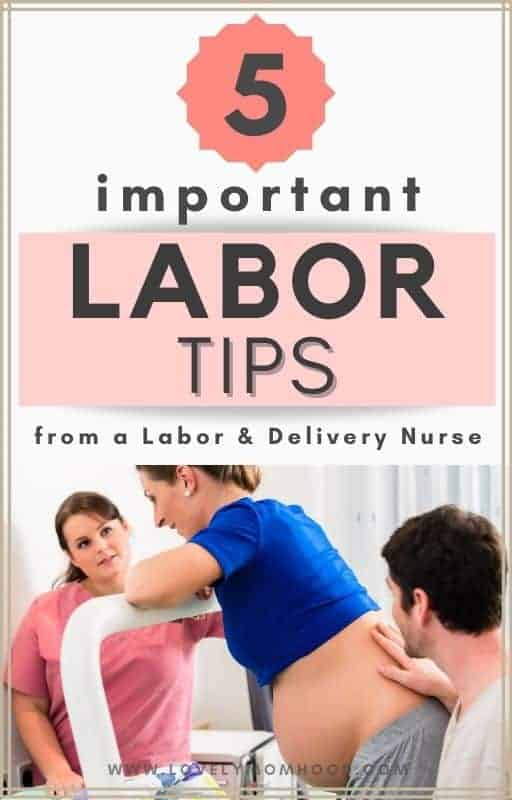5 Normal Delivery Tips (from a Labor and Delivery Nurse & Mom)
Normal delivery tips are one of the most inquisitive subjects for moms-to-be. After all, having a vaginal delivery can feel intimidating and, well… scary, to say the least.
Therefore, I wanted to put together a few important “normal delivery tips” to help you feel prepared and empowered throughout the birthing process.
To help us do that, I have enlisted the help of a fellow nurse, Liesel Teen, founder of Mommy Labor Nurse, course instructor, and creator of the popular Birth it Up Series.

As a labor and delivery nurse and mom of two, Liesel has been passionate about birth for as long as she can remember. She loves sharing her nursing knowledge to help mamas-to-be learn more about pregnancy and birth.
In this article, I will share 5 important natural delivery tips Liesel was kind enough to share.
As a mom of two (with vaginal deliveries) and a nurse myself, you will also find additional labor and delivery tips scattered along the way from my personal experience. You will find those additional “From Personal Experience” tips under each of Liesel’s normal delivery tips.
But, before we get into the good stuff…
What is a “normal delivery”?

“Normal delivery” is quite a funny term. After all, most of our birthing experiences are far from “normal,” as they all have a personal spin on things.
From a medical perspective, a “normal delivery” is most commonly referred to as the vaginal delivery of a baby by the mother without any medical intervention. However, from the purpose of this article—and the popular demand of inquiring moms-to-be—the following “normal delivery tips” included here will apply to vaginal births, with or without pain medication or other intervention means.
After all, labor and delivery could prove quite, well, unpredictable. Hence, Liesel’s first normal delivery tip…

* This post contains affiliate links. Click here for more info.
1. Try to keep an open mind
I think many mamas have a vision of what they want their birth to be like. But one thing that’s true about birth – is that it can be super unpredictable!
I’m a big advocate for creating a birth plan and discussing your birth wishes with your provider and support team ahead of time. But I always recommend this with a pretty big caveat – you’ve got to do your best to keep a flexible and open mind.
The last thing I want is for you to have some sense of disappointment or doubt after your birth because it wasn’t exactly what you had envisioned. The first goal is always for the baby and mama to be healthy and safe.
From my experience
I can’t agree more with Liesel about this! Labor isn’t some computerized and orchestrated event. It is very real, very human, and very evolving.
As Liesel mentioned, it is extremely important to have a plan and to be knowledgeable about what to expect. However, having an open mind and embracing the process are crucial aspects of the experience.
As for me, both of my births happened vaginally, as I had planned, but many things transpired in between I wasn’t necessarily… expecting.
For instance, one epidural worked, and one didn’t. One breastfeeding journey was successful; one wasn’t. One after birth came with a wave of postpartum depression, one didn’t… but all in all, what helped tremendously was to “go with the flow”—or “let go and let God”—embrace the experience, learn from it, and share it with others that might find it helpful.
2. Prepare ahead of time and have all your bases covered
Moving along with this open-mind idea is focusing on “preparation in the form of education!” The more knowledgeable you are about the birth process, how to cope with the pain, and the possible interventions that might be necessary, the better birth you’re going to have.
When choosing a childbirth class, try to find one that teaches about medical interventions with an open mind and covers natural pain coping strategies! This is exactly why I designed my birth classes the way I did.
Birth It Up: The Natural Series is geared for mamas who want an unmedicated birth but still teaches about medical interventions, including the process of an epidural and emergency C-sections, just in case it is what’s right for you! So many mamas share their #birthitupbaby birth stories and say they’re SO glad the course covered epidurals because they ended up wanting one!
Birth It Up: The Epidural Series, I have an entire lesson called “Oops, I accidentally went natural!” Because sometimes labor is so dang fast, there’s no time for an epidural, and I want you to have strategies in your toolbox for how to deal with labor pain before your epidural is placed or if an epidural isn’t possible!
Birth it Up: The C-Section Series I created specifically for moms who know they will be having a C-section ahead of time. This series will answer every what-if so you can approach your birth with confidence and a sense of control, including preparing mentally and emotionally for the big day, what to expect, the medical aspect of the c-section, and education on the recovery process.
From my experience
I cannot tell you how important it is to have some knowledge beforehand about the labor and delivery process. If I could only give you ONE “normal delivery tip,” I would tell you to take a really good childbirth class.
Why? Just like in any of Liesel’s childbirth courses, they will provide various techniques, procedures, and resources to prepare you for anything you might encounter in the delivery room. Whether it be a natural birth, getting an epidural, or having a c-section… NOTHING is off the table until the baby arrives.
You would think that as a nurse who studied Labor and delivery as part of my nursing requirements before I had children, I would be ready for what to expect in my labor, right? I was so wrong.
I learned the hard way that when it comes to labor and delivery for first-time mamas, despite your background, nothing beats a step-by-step, informative, yet practical child-birthing class geared toward moms-to-be. And that is what you will find in Liesel’s Birth it Up Series.
3. Practice pain-coping strategies BEFORE you’re in labor

And on the note of pain-coping strategies, practice them before you need them! Contraction pain is no joke, and it can be really hard to summon some of those relaxation techniques or breathing exercises if you’re not already a pro.
Regularly practicing these strategies before the big day will be second nature. Inside Birth It Up, you’ll learn many mental and physical pain-coping techniques to help you on the big day.
From my experience
Ohhhh… labor pain! I’m not quite sure I can describe the feeling. Thankfully, there are many ways you can cope with labor pain: learning—and practicing—labor pain coping techniques.
“But I’ll be getting an epidural!” You might say?
Well, unfortunately, that does not necessarily guarantee you pain-free labor. From experience, I can tell you that not all epidurals work the same, and some don’t work at all. How do I know? Well, with my second child, the epidural was as good as nothing, so taping into my pain-coping techniques was a great option it was my only option!
In addition, epidurals are typically not given right away. Usually, epidurals are administered after active labor has been reached. So inevitably, during early labor, you will experience some irregular contractions along the way before active labor commences and pain medication can be administered.
So, there is no doubt that practice makes perfect! And preparing for labor is no exception. As you learn the labor and delivery techniques, such as pain coping methods, exercises, and breathing … practicing them beforehand is a great idea. So that, when the time comes, the techniques will be familiar to you.
4. Get your team ready
So, as you probably know, I’m a labor and delivery nurse, but one area where I seriously failed at preparing for my first birth? I didn’t prepare my husband AT ALL! The poor guy had no idea what he was getting into, and it was really hard for him to see me in so much pain.
Don’t be like me, hah!! Make sure you prepare for birth WITH your partner or other support people. Take a birth class together and practice ways they can support you during labor and immediately after birth.
All three of my birth classes have got your partners covered! There are specific lessons noted to watch with your partner (if they don’t want to do the whole thing!), partner-specific tips, AND some printable cheat sheets just for them.
From my experience
It is easy to forget about the dad-to-be and this whole birthing thing. After all, they aren’t the ones with morning sickness, stretch marks, heartburn, or being kicked in the rib cage every 5 minutes!
So, Daddy, who, right?
Okay, just kidding. We need them, especially in the labor and delivery room. So, instructing them what to do and when to do it can go a long way when it comes time to have the baby.
Birthing classes helped my husband know what to expect, how to help me through the contractions, and key things to help me do once the baby was born.
As Liesel mentioned, don’t skip this crucial normal birth tip.
Involve the dad-to-be (and/or any other support system in the labor and delivery room with you) in your birthing class. Thankfully, the Birth it Up Series Courses are online and pre-recorded. So you can watch them over and over on your own time and with your entire support group.
5. Don’t forget about postpartum and newborn care, too!
Labor and delivery is only the beginning of your motherhood journey and, thankfully, the faster part.
So, part of preparing for your birth is preparing for your postpartum recovery and newborn care, too!
I have created resources that help you prepare for just that, and you can find them all in any of the three courses.
From my experience
So, you did it!!! You had the birth of your dreams (God-willing), you were able to follow your birth plans (hopefully), you pushed through the pain (inevitably), and now you have this gorgeous little being in your arms…. now what?
- How do you implement postpartum care?
- How do you care for a newborn?
- How do you go about breast or formula feeding?
Just when you think most of the work is over, after the baby is born, the REAL work begins.
So, postpartum care and newborn care become fundamental aspects of preparing to have a baby.
The good news is that you can learn these things beforehand to feel prepared and empowered to tackle postpartum and motherhood head-on.
Related Articles:
- How to Prepare for Labor (The Ultimate List)
- The Ultimate DIY Postpartum Care Kit (Natural & Non-Toxic)
- What to Wear After a Hospital Birth (from Head to Toe)
- 10 Positive Birth Stories (Natural & C-Section)
In Summary
Every mom-to-be aspires to have a normal delivery. We want nothing more than for everything to go as planned and as “uneventful” as possible.
With that said, labor will almost always prove to be anything but uneventful, and plans won’t always go as hoped for.
We could, however, learn all we can about the labor and delivery process and birthing techniques. And that will ensure that we are prepared and empowered to tackle any demanding task that labor and delivery can throw our way.
I hope these 5 normal delivery tips are helpful and useful to you when it is time for labor.
Remember to enjoy the process and embrace the changes. After all, delivering a happy and healthy baby truly matters.
Good luck, my friend! Happy and healthy birthing. 🙂
How far along are you in your pregnancy? What normal delivery tips will you be implementing from this list?
